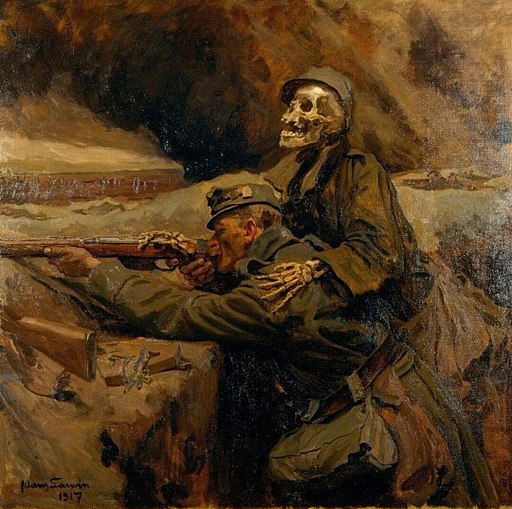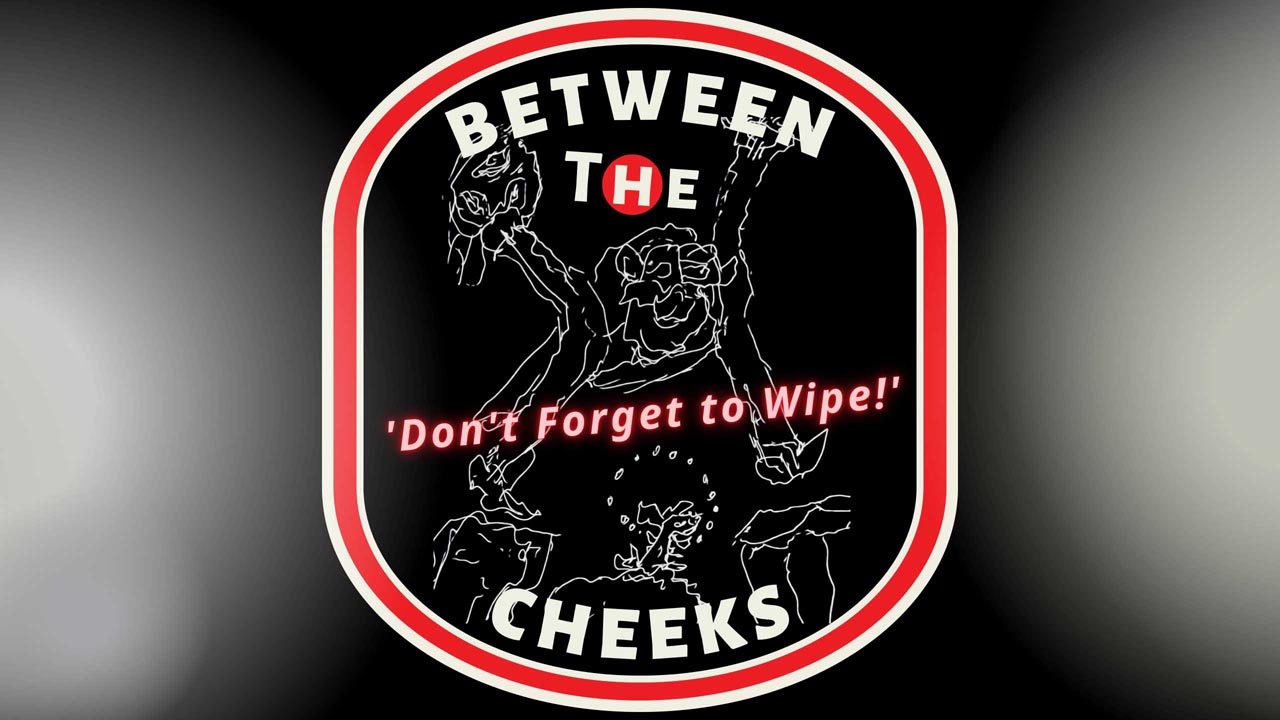The Psychology of WAR
The following is a transcript of this video.
“Will men be able to give up toying with the idea of another war? It is now a question of existence or nonexistence. . .For the danger that threatens us now is of such dimensions as to make this last European catastrophe [i.e., World War II] seem like a curtain-raiser.”
Carl Jung, Epilogue to “Essays on Contemporary Events”
War is deeply engrained in our culture, our society, and our psyches. Through movies, television shows, and video games, the entertainment industry glorifies the horrors of war, politicians and bureaucrats gain power through the fighting of wars, and many corporations are enriched through the production of the weapons of war. War is also deeply embedded in our history. We have fought wars since our time as hunter gatherers, and war remains one of the most influential forces shaping the course of civilization. But we face a dilemma: war may be entrenched in our society, but the technologies of war have become so destructive that if war breaks out between two major powers it has the potential to end civilization as we know it.
“War has become an activity that has surpassed the ability of human beings to endure it.”
Richard A. Gabriel, No More Heroes: Madness and Psychiatry In War
In this video we explore the psychology of man as it relates to war. We examine whether we are psychologically built for the stress of war, if we are by nature killers, and how militaries utilize psychological conditioning techniques to transform young men from peace-loving beings into soldiers who kill on command.
Given the chronic persistence of war, the Latin proverb Homo homini lupus, or man is a wolf to man, seems to ring true. But other than a very small fragment of the population, who display psychopathic traits of excessive violence and aggression, human beings are not psychologically fit to fight in modern wars. Almost every soldier who spends time in active combat, on the front lines of a major war, is psychologically harmed by the experience. World War II veteran William Manchester went as far as to suggest that to endure the horrors of war it is necessary to adopt a mindset, that in any situation other than war, would be characterized as insane, or as he wrote:
“No man in battle is really sane. The mindset of the soldier on the battlefield is a highly disturbed mind, and this is an epidemic of insanity which affects everybody there—and those not afflicted by it die very quickly.”
William Manchester, quoted in War: The New Edition by Gwynne Dyer
The stress of battle is immense. A soldier knows he could die at any moment, and his senses are overwhelmed with the sights, sounds, and smell of the dying, many of whom are his friends. War also makes life unpredictable. A soldier in active battle loses control of his fate and is burdened with the unremitting hostility of an enemy who wants his blood. If bullets and bombs do not destroy his body, the experience of war will destroy his mind. Or as a World War II Army Medical report explains:
“. . .the key to an understanding of the psychiatric problem [of war] is the simple fact that the danger of being killed or maimed imposes a strain so great that it causes men to break down. One look at the shrunken, apathetic faces of psychiatric cases as they come stumbling into the medical station, sobbing, trembling, referring shudderingly to ‘them shells’ and to buddies mutilated or dead, is enough to convince most observers of this fact. There is no such thing as ‘getting used to combat.’ Each man ‘up there’ knew that at any moment he might be killed, a fact kept constantly before his mind by the sight of the dead and mutilated buddies around him.”
Quoted in Cohesion, Anticipated Breakdown, and Endurance in Battle by David Marlowe
A soldier’s breakdown is not a result of cowardice, as courage is no antidote to the stress of war. With enough time virtually every soldier is mentally harmed by his time in battle, or as the World War II Army Medical report explains:
“Each moment of combat imposes a strain so great that men will break down in direct relation to the intensity and duration of their exposure. Thus, psychiatric casualties are as inevitable as gunshot and shrapnel wounds in warfare …”
Quoted in Cohesion, Anticipated Breakdown, and Endurance in Battle by David Marlowe
Richard Gabriel echoes this insight in his book No More Heroes: Madness and Psychiatry In War:
“There is no evidence to support the commonly held view among the civilian populace, fostered by movies and television programs, that only the weak or the cowardly break down in battle. In reality, everyone is susceptible to psychiatric breakdown in war.”
Richard A. Gabriel, No More Heroes: Madness and Psychiatry In War
But it is not just the ever-present threat of death, or the experience of one’s comrades dying, that leads to the psychiatric casualties of war. It is also due to the fact that the soldier’s primary job, that of killing other human beings, is a deeply repulsive act that most people want no part of. Or as Lieutenant Colonel David Grossman writes in On Killing: The Psychological Cost of Learning to Kill in War and Society:
“. . . despite an unbroken tradition of violence and war, man is not by nature a killer.”
David Grossman, On Killing: The Psychological Cost of Learning to Kill in War and Society
Grossman goes as far as to suggest that not only do we naturally abhor the act of killing another human, most of us even loath hostility or confrontation, or as he writes:
“Most avoid confrontations at all costs, and to work ourselves up to an aggressive verbal action—let alone a physical confrontation—is extremely difficult. Simply confronting the boss about a promotion or a raise is one of the most stressful and upsetting things most people can ever bring themselves to do, and many never even get that far. Facing down the school bully or confronting a hostile acquaintance is something that most will avoid at all costs.”
David Grossman, On Killing: The Psychological Cost of Learning to Kill in War and Society
Some may think that our resistance to killing would disappear in the throes of battle. Place a gun in our hand and an enemy force in front of us and our instincts will lead us to kill. This, however, is not the case. Most people will not fire on an enemy unless they have been properly trained to kill and psychologically conditioned to overcome their repulsion toward taking the life of another man. A study by the US Army Brigadier General S.L.A. Marshall, during World War II, brought this fact to light.
Marshall and a team of researchers interviewed combatants who fought in Europe and the Pacific in order to understand what they did during their time on the front lines. What they discovered shocked them – the overwhelming majority of men never fired their weapons at enemy troops. Marshall’s methodology has been criticized, but few deny his essential conclusion that even soldiers in battle are repulsed by the act of killing. Or as Grossman explains:
“Those who would not fire did not run or hide (in many cases they were willing to risk great danger to rescue comrades, get ammunition, or run messages), but they simply would not fire their weapons at the enemy, even when faced with repeated waves of [enemy] charges.”
David Grossman, On Killing: The Psychological Cost of Learning to Kill in War and Society
Intrigued by the results of Marshall’s study, historians looked back at other wars and found evidence of similarly low rates of firing. For example, battlefield excavations from the American Civil War discovered a high proportion of muskets that were loaded multiple times, but never fired, suggesting that only a minority of soldiers ever discharged their weapon.
What accounts for the reluctance to fire? Interviews with soldiers led Marshall to conclude that “the average and healthy individual…has such an inner and usually unrealized resistance towards killing a fellow man that he will not of his own volition take life if it is possible to turn away from that responsibility….” (S.L.A Marshall, Men Against Fire)
That man would avoid killing another man, even in war, is not surprising, as killing another human being is one of the most traumatic experiences one can endure. Many soldiers who have opened up about the experience display immense guilt and remorse for what war forced them to do. For example, after killing a Japanese soldier at close range during World War II, the US marine William Manchester wrote:
“I can remember, whispering foolishly, ‘I’m sorry’ and then just throwing up…I threw up all over myself. It was a betrayal of what I’d been taught since a child.”
William Manchester, quoted in On Killing by David Grossman
This sentiment was echoed by a US Special Forces officer who killed a boy during a Vietnam war battle.
“I froze, ’cos it was a boy, I would say between the ages of twelve and fourteen. When he turned at me and looked, all of a sudden he turned his whole body and pointed his automatic weapon at me, I just opened up, fired the whole twenty rounds right at the kid, and he just laid there. I dropped my weapon and cried.”
U.S. Special Forces officer and Vietnam veteran quoted in Soldiers: A History of Men in Battle by John Keegan and Richard Holmes
While repulsed by the act of killing, most of us can be conditioned to overcome this repulsion and, in the process, turned into a lethal killer. Following Marshall’s discovery of low firing rates in World War II, the US army made a concerted effort to increase this rate by implementing new training methods and other psychological conditioning techniques. These techniques were successful. By the Vietnam war estimates suggest that the firing rate reached upwards of 80%. These training methods include reflexive firing drills at realistic human shaped targets and training scenarios that simulate the stress of combat. These techniques help lay down neural pathways that condition men to fire without thinking too much about what they are doing, or as the historian Gwynne Dyer explains:
“That an infantry company in World War II could wreak such havoc with only about one-seventh of the soldiers willing to use their weapons is a testimony to the lethal effects of modern firepower, but once armies realized what was actually going on, they at once set about to raise the average. Part of the job can be done by weapons training that actually lays down reflex pathways that bypass the moral censor. The long, grassy fields with bull’s-eyes propped up at the end give way to combat simulators with pop-up human silhouettes that stay in sight only briefly: fire instantly and accurately and they drop; hesitate and they disappear in a couple of seconds anyway. But conditioning the reflexes only does half the job; it is also necessary to address the psychological reluctance to kill directly. These days soldiers are taught, very specifically, to kill.”
Gwynne Dyer, War: The New Edition
Dyer suggests that modern military training exerts an almost religious like conversion on the recruit. Before enlisting the recruit is typically a young man constrained by the moral prohibitions against violence and naturally repulsed by the act of killing. If training is effective, he is transformed into a soldier who kills on command.
“Just how this transformation is wrought varies from time to time and from country to country. In totally militarized societies—ancient Sparta, the samurai class of medieval Japan, the areas controlled by organizations like the Liberation Tigers of Tamil Eelam today—it begins at puberty or before, when the young boy is immersed in a disciplined society in which only the military values are allowed to penetrate. In large modern societies, the process is briefer and more concentrated, and the way it works is much more visible. It is, essentially, a conversion process in an almost religious sense. . .”
Gwynne Dyer, War: The New Edition
One of the most important factors in this conversion process is the fostering of a strong group solidarity among recruits. When a deep sense of camaraderie is formed – and a man is conditioned to believe in the moral superiority of his group – he can be driven to commit atrocities he would never have imagined doing on his own. Soldiers often become so close to those in their military units that they will fire upon the enemy, rather than risk letting down their comrades. Or as Grossman writes:
“A tremendous volume of research indicates that the primary factor that motivates a soldier to do the things that no sane man wants to do in combat (that is, killing and dying) is not the force of self-preservation but a powerful sense of accountability to his comrades on the battlefield.”
David Grossman, On Killing: The Psychological Cost of Learning to Kill in War and Society
A tight group bond also diminishes the feelings of guilt associated with the act of killing by granting each individual soldier a sense of anonymity and moral irresponsibility. Or to paraphrase the zoologist and ethnologist Konrad Lorenz “man is not a killer, but the group is.”
A third effect of group solidarity is the intensification of emotion. Groups tend to magnify and mirror any strong emotions that arise in its individual members. If, therefore, a military unit contains a few soldiers with strong feelings of hatred toward the enemy, or who are particularly aggressive, these emotions can spread to other members and be magnified in the group setting. Ben Shalit, who was an Associate Professor at the National Defense Research Institute in Sweden, explains:
“All crowding has an intensifying effect. If aggression exists, it will become more so as a result of crowding. . .It has been shown by some studies…that a mirror in front of an aggressor tends to increase his aggression—if he was disposed to be aggressive… The effect of the crowd seems to be much like a mirror, reflecting each individual’s behavior in those around him and thus intensifying the existing pattern of behavior.”
Ben Shalit, The Psychology of Conflict and Combat
In addition to promoting group solidarity, another method of conditioning men to kill is through the age-old technique of dehumanizing the enemy. Soldiers are subject to immense amounts of propaganda that depict the men and women they are sent to kill as less than human and their very existence as a threat to all that is good and true.
“The basic aim of a nation at war is establishing an image of the enemy in order to distinguish as sharply as possible the act of killing from the act of murder.”
Glenn Gray, The Warriors
Or as Richard Gabriel writes:
“Men dehumanize the enemy as the only way to justify their own horrible acts. Otherwise, it would be impossible to remove the blood from the soldier’s hands.”
Richard A. Gabriel, No More Heroes: Madness and Psychiatry In War
Of all the means to minimize man’s reluctance to kill, however, the most effective is to maximize the physical distance between the killer and his victim. It is far easier to kill a man from hundreds of meters away with a bullet, than it is to kill in hand-to-hand combat, and easier still to drop a bomb or fire a missile at distances so great that the victims never enter the killer’s field of vision. The most horrifying form of killing occurs when one must look the victim in the eyes, which as Grossman writes, can explain why:
“. . .Nazi, Communist, and gangland executions are traditionally conducted with a bullet in the back of the head, and why individuals being executed by hanging or firing squad are blindfolded or hooded. And we know from Miron and Goldstein’s 1979 research that the risk of death for a kidnap victim is much greater if the victim is hooded. . .The eyes are the window of the soul, and if one does not have to look into the eyes when killing, it is much easier to deny the humanity of the victim.”
David Grossman, On Killing: The Psychological Cost of Learning to Kill in War and Society
With advanced training and psychological conditioning techniques and weapons that increase the physical distance between the soldier and his victims, most men can be transformed into killers. And this does not bode well for preventing the outbreak of a third world war. For as Dyer writes:
“. . .if the inhibition against killing can be removed in most people by a little routine psychological conditioning, then we still have a lot to worry about.”
Gwynne Dyer, War: The New Edition
To make matters worse, most modern politicians are psychologically unstable, do not place much value in the lives of the masses and are highly influenced by the powerful institutions, individuals, and corporations that benefit from the act of war. The former major general in the marines and American whistleblower Smedley D. Butler wrote:
“WAR is a racket. It always has been. It is possibly the oldest, easily the most profitable, surely the most vicious. It is the only one international in scope. It is the only one in which the profits are reckoned in dollars and the losses in lives.”
Smedley D. Butler, War is a Racket
While billions of dollars are transferred from the tax paying citizenry to the military industrial complex, war also centralizes the power of the state. War provides a ready-made justification for increased government control, allowing politicians to strip the citizens of their rights, and force them to do things that would never be permitted in times of peace. In George Orwell’s 1984 the totalitarian government used perpetual war to maintain a tight control over the citizenry of Oceania. And while Orwell’s book is fiction, the lessons it teaches are not. Or as Gerard Casey explains in his book Freedom’s Progress?
“In war, all power and control moves inexorably towards the centre. A war, any war, is essential to keep it there. If an external enemy can’t be found, then an internal enemy must be discovered or manufactured.”
Gerard Casey, Freedom’s Progress?
Or as Randolph Bourne famously put it:
“War is the health of the state. It automatically sets in motion throughout society those irresistible forces for uniformity, for passionate cooperation with the Government in coercing into obedience the minority groups and individuals which lack the larger herd sense.”
Randolph Bourne, The State
As so many in the ruling class see gains from the fighting of wars, we should not rely on these individuals to maintain peace. The responsibility lies with us. More people need to see through the lies and propaganda that are used to justify war, and more people need to be vocal in expressing their anti-war views. For speaking up, and protesting against war, is effective. In the buildup to war, governments often censor and even jail the dissidents who spread anti-war messages, and this would be unnecessary if these messages didn’t have the potential to shift public sentiment.
The American political activist Eugen Debs, who was sentenced to ten-years in prison under the Sedition Act for his speeches denouncing America’s participation in World War I, recognized the power of the anti-war voice. He also realized that it is always the ruling powers, never the people, who push a nation into the hell of war, or as he wrote:
“They have always taught and trained you to believe it to be your patriotic duty to go to war and to have yourselves slaughtered at their command. But in all the history of the world you, the people, have never had a voice in declaring war, and as strange as it certainly appears, no war by any nation in any age has ever been declared by the people.”
Eugene Debs, Speech June 16, 1918
The great Russian author Leo Tolstoy echoes this sentiment:
“In all history there is no war which was not hatched by the governments, the governments alone, independent of the interests of the people, to whom war is always pernicious even when successful.”
Leo Tolstoy, On Patriotism
If we are not ruthless in expressing our hatred of war and ostracizing those who push us toward war, then if another major war breaks out, responsibility lies in part with us. And given the advanced weapons of war that now exist, the next major war will create a hell on earth not just for the soldiers that fight it, but for every single one of us, or as Dyer writes:
“The brief, one-sided campaigns of well-armed Western countries against dysfunctional Third World autocracies kill in the tens of thousands, and the genocidal ethnic conflicts of fragile post-colonial states are local tragedies, but during the last two years of World War II, over one million people were being killed each month. If the great powers were to go to war with one another just once more, using all the weapons they now have, a million people could die each minute.”
Gwynne Dyer, War: The New Edition
1 comment
Leave a comment
Only members can post comments. Login, or become a member, to post a comment.










A lot of criticism of warmongering governments, and rightly so. I really hope to see a series on anarchism, or at least, on the coercive power of the State. Thanks a lot for your work